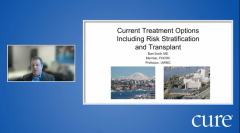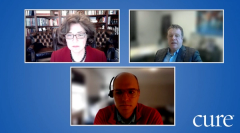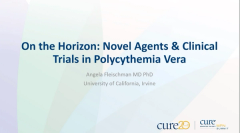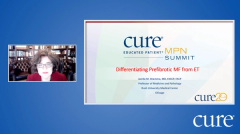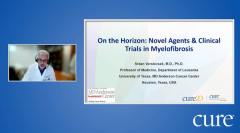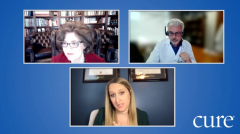
Educated Patient® MPN Summit Disease Approaches Panel: May 7, 2022
Watch Dr. Jamile Shammo and Dr. Srdan Vestovsek answer questions about disease approaches during the CURE Educated Patient MPN Summit.
Episodes in this series

This panel was moderated by Kristie L. Kahl, and featured Dr. Jamile Shammo and Dr. Srdan Vestovsek.
Kahl: Dr. Shammo, we had a patient, her mother was diagnosed with ET in the 1960s. Then she received a PV diagnosis in 2000. So what should her children do to prepare for maybe a potential MPN diagnosis?
Shammo: Yeah, you know, I've seen this happens often. And I think the problem is that there is no accountability, or I should say, no accounting for iron status in patients who have ET. Okay, if you look at the WHO criteria, I mean, the only way that you can say, okay, maybe there's a masked PV is if someone did an iron stain, and then on the bone marrow, and they see abs and iron, okay. And in which case, you could say, well, perhaps this is masked PV presenting, or just thrombocytosis. And the patient is iron deficient, in which case, they don't have sufficient Island to generate a very high hemoglobin, which is sufficient to make a diagnosis of PV. But then ultimately, and especially women, they end up entering menopause, and then suddenly, that iron deficient state gets rectified. So then the diagnosis ends up turning from ET to PV because now all of a sudden, their hemoglobin goes up from 1415 to 18. I've seen this, and maybe we should look into it and write up about it. But nevertheless, PV obviously means it has to be treated as PV. And it has to be followed with appropriate, inadequate care off and making sure that the guidelines for treating leukocytosis and making sure that she's on cytoreduction, because I'm not sure what the age is right now. So all those particular recommendations should be followed as such. But I do think that that point relative to iron monitoring is missing in the guidelines. I don't know if Dr. Vestovsek it has comments on that.
Vestovsek: If I may add to what you explained very well, PV certainly is the issue. The other way of people changing from ET to PV is that they really evolve. About 10% of the patients that have ET will over time become full-fledged PV they acquired high red blood cell count. These are those that have a JAK2 mutation. And that happens through perhaps enhancement of the growth of the cells and the number of cells with the active mutation in the body of the patients go high. For example, at the time of diagnosis, only about 10% of the patients, or 10% of the cells in the body of ET patients are affected by the JAK2 mutation, where the typical percent of cells at the time of diagnosis of PV patient is about 45. So if the patients over time living with the condition for 10 to 20 years, we will experience the higher and higher percentages of malignant cells in the blood. It may then lead to transformation or evolution to polycythemia vera.
Now the question was asked about what the family should do about it. And I would assume you're asking about themselves. There is no need to test anybody in the family. The by and large ET, PV or MF are required. There is certain predisposition 7% of a larger family may have one or the other on another one that we didn't even mention of MPNs that will show up on annual physical when you don't see it, if at all happens, it's not inherited in a way that I will give it to you or you will get it to me. So no need to worry or to test any family members at all.
Kahl: Okay, great. And then Dr. Vestovsek, we had a question come in, is there any CRISPR trials for myelofibrosis triple-negative patients?
Vestovsek: First, you will need to have a genetic abnormality that you need to compare, fix. And then that would be the one that is absolutely important and drives this process. We know that is driver mutations JAK2 people are essential, but not the only one important, particularly MYELOFIBROSIS there are many other mutations and what this patient asked about or what the question was about is 10% of the myelofibrosis patients don't have any of these JAK2 abnormalities. Some other abnormalities are behind it. And that will be the least favorable environment for kind of a CRISPR-type of technique to help the patient because what's the problem? Right? You need to prefix it, you don't really know what it is. So I don't see this technique to be applicable to Marlowe fibrosis patients or any other MPN at all, because of the issues I outlined earlier on.
Kahl: This question came in earlier, if excess EPO could be turned off to prevent the JAK-STAT cycle, would that be a target for therapy? I think I can throw that out to either one of you.
Shammo: I think maybe they were talking about hepcidin. I don't know about excess EPO. Because that was the point that Angela Fleischman was bringing up about novel agents for PV. Because in PV, you would expect the EPO to be really, really low. But the point was to say that hepcidin is really, really low in PV, and that would be the point of hepcidin. So I didn't know that we could do EPO is by default low in this in PV.
Kahl: Dr. Vestovsek, we had a question. A patient says that they have myelofibrosis and very low ferritin levels up until menopause. So suddenly, her level skyrocketed and then came down again, is this normal?
Vestovsek: It is not normal for myelofibrosis. But I don't know what the clinical relevance of this particular finding is, was during the pre menopause way, patient was iron deficient at the same time, because of the menstrual bleeding. Typically, in patients with myelofibrosis, ferritin goes up, because it's one of the inflammatory markers. We don't need to utilize it beyond just looking at perhaps in some patients. But in general, it's really difficult to say what's the clinical relevance of this? I would really like to see the patient in my clinic, there was an email, send me the email and we'll arrange for this.
Kahl: One question also just came in, are there doctors or clinics that review rare cases? So I think this could also be an opportunity for each of you kind of highlighting the importance of making sure you're seeing a specialist especially because MPN can be on the rare side?
Vestovsek: Absolutely, absolutely. I mean, look, myelofibrosis, one new case in 100,000 a year in the United States, that's about three and a half per 1000 new cases, maybe 20,000 People live with myelofibrosis, many more with ET and PV, maybe 130, 140 of each with each disease. But for one of those in particular, you'll see how complicated this is. A second opinion is always good. I tell my patients that come that I discovered they have MPN seek a second opinion. It's always good to know more than less.
Shammo: I agree. I think you want to see a physician whose clinic is enriched with those rare cases, because then it isn't so rare anymore.
Kahl: Well, we are running out of time. So I wanted to just get final thoughts from each of you, and maybe you know, what you hope our patients can take away from today? Or maybe what they have to look forward to. We've heard a lot of great information this afternoon. So Dr. Vestovsek, I'll start with you.
Vestovsek: Well, I was actually so happy to see that I was asked to predict the future in a way, right. They don't teach us in a medical school how to see the future. But look, so much is happening. It's incredible. That 15 years ago, there was nothing I could do for my patients and 2011 first drug approved, then another one and then another one. And we are in this rolling that will produce the next three to five years, a number of additional new medications. And we're going to start talking about combinations and completely different views of looking at the biology and therapies that we are developing. And then eventually we'll get to the individualized approach in terms of targeting something specifically abnormal, malignant versus normal, right. So selection of the malignant cells versus normal. So really exciting time. I think a lot our patients to joining us in this well for now never-ending fight but we are winning it slowly. And so only between us we can make progress. And so I really appreciate to have everybody listening tonight and given the opportunity to share my views where we are going to go together in the future
Shammo: I’s like to also thank you for inviting me to participate in this effort and I totally second that sentiment, because this truly is a shared effort and responsibility not just on physicians part but also on patients part so they could partake in this tremendous task. We understand a lot more about MPNs than we did in the past. But we have a whole lot more to do. I mean, lots of first off sixth presentation was beautiful and very complex and there was a lot to be accomplished, but the future is bright. So stay tuned.
Raw transcriptions have been lightly edited for clarity.
For more news on cancer updates, research and education, don’t forget to

